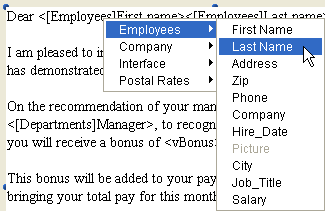4D v16.3
Using references in static text
- 4D Design Reference
-
- Building forms
-
- Form editor
- Form properties
- Form Properties (Explorer)
- Creating a multi-page form
- Using inherited forms
- Modifying data entry order
- Inserting and organizing form objects
- Setting object display properties
- Rotation of text
- Using static pictures
- Using references in static text
- Duplicating on a matrix
- Incrementing a set of variables
- Scaling a form
- Using object methods
- Using object views
- Using shields
- Using the preconfigured library
- Creating and using custom object libraries
- Displaying information about objects on forms being executed
 Using references in static text
Using references in static text
You can use the current values of fields and variables as well as table and field names in your static labels in order to set up dynamic interfaces.
You can insert these dynamic labels into the following types of static text:
- static text areas themselves (Text or Group Box object),
- names of form windows,
- Help tips and help messages (see Data entry controls and assistance).
Note: Dynamic references based on XLIFF (XML) architecture, particularly suitable for interface translation, can also be used in these labels, as well as menu and button labels. For more information, refer to Appendix C: XLIFF architecture.
In the Form editor, you can choose the version of the labels to display by selecting either Show Name or Show Resource in the Object menu.
You can embed field names or variable names in static text areas. When the text area is displayed or printed, the values of the fields or variables from the current record are substituted. Use embedded fields and variables to create mail-merge documents and in report headers and footers.
You can embed the field or variable name by inserting it between the < > symbols.
- You can use a field from any table in the database. Fields from the current table do not have to specify the table name; they can be entered like this: <FieldName>. Fields from other tables must specify the table name; they are entered like this: <[TableName] FieldName>. When the form is printed, the information from the field for each record replaces the <FieldName> element in the text area.
- A variable must be inserted like this: <VariableName>. Make sure that the value of each variable is assigned by an object or form method.
You can specify how an embedded field or variable is displayed by inserting a semicolon followed by a display format directly after the field or variable name. For example, the embedded variable <vTotal;$###,##0.00> calculates the amount of the person’s total pay for the month and displays it in a dollar format. For more information about display formats, refer to Display formats.
For an example of mail-merge documents using embedded fields and variables, refer to Creating mail-merge documents.
You can use a pop-up menu to insert a field reference into a block of static text:
- Select the text tool
 .
. - Click in the static text area while holding down the following keys:
- Alt (Windows) or Option (Mac OS) to display a pop-up menu containing fields from the table (this menu only works with table forms).
- Alt+Shift (Windows) or Option+Shift (Mac OS) displays a hierarchical menu of tables and fields in the database.

You can insert dynamic table and field names into your forms (as static text). When you place dynamic table or field names in your forms, they are automatically updated throughout your database when you modify the table or field name in the Structure editor or when the 4D SET TABLE TITLES and SET FIELD TITLES commands are called. This feature is particularly useful for translating the structure of the application that is visible to the user.
- To insert a dynamic table name: <?[TableName]> or <?[2]> (the table’s creation order number, meaning the second table created).
- To insert a dynamic field name: <?[TableName]FieldName> or <?[2]3> (the table’s and field’s creation order number), or even <?3> (the field’s creation order number) for a field of the current table.
Remember that since field and table numbers correspond to their creation order, it is possible to add or rename tables and fields without affecting the system of dynamic references.
Note: Dynamic field names are available as an option on the Options page of the Form Wizard (refer to Creating a form using the Form Wizard).
Product: 4D
Theme: Building forms
structure virtuelle
4D Design Reference ( 4D v16)
4D Design Reference ( 4D v16.1)
4D Design Reference ( 4D v16.3)









